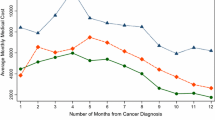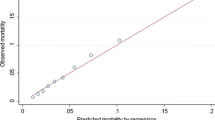Abstract
Background: Determining the apportionment of costs of cancer care and identifying factors that predict costs are important for planning ethical resource allocation for cancer care, especially in markets where managed care has grown.
Design: This study linked tumor registry data with Medicare administrative claims to determine the costs of care for breast, colorectal, lung and prostate cancers during the initial year subsequent to diagnosis, and to develop models to identify factors predicting costs.
Subjects: Patients with a diagnosis of breast (n=1,952), colorectal (n=2,563), lung (n=3,331) or prostate cancer (n=3,179) diagnosed from 1985 through 1988.
Results: The average costs during the initial treatment period were $12,141 (s.d.=$10,434) for breast cancer, $24,910 (s.d.=$14,870) for colorectal cancer, $21,351 (s.d.=$14,813) for lung cancer, and $14,361 (s.d.=$11,216) for prostate cancer. Using least squares regression analysis, factors significantly associated with cost included comorbidity, hospital length of stay, type of therapy, and ZIP level income for all four cancer sites. Access to health care resources was variably associated with costs of care. Total R 2 ranged from 38% (prostate) to 49% (breast). The prediction error for the regression models ranged from <1% to 4%, by cancer site.
Conclusions: Linking administrative claims with state tumor registry data can accurately predict costs of cancer care during the first year subsequent to diagnosis for cancer patients. Regression models using both data sources may be useful to health plans and providers and in determining appropriate prospective reimbursement for cancer, particularly with increasing HMO penetration and decreased ability to capture complete and accurate utilization and cost data on this population.
Similar content being viewed by others
References
D.P. Rice, T.A. Hodgson and F. Capell, The economic burden of cancer, 1985: United States and California, in: Cancer Care and Cost: DRGs and Beyond, eds. R.M. Scheffler and N.C. Andrews (Health Administration Press, Ann Arbor, MI, 1989), pp. 39–59.
R. Rundle, Sellick pioneers selling cancer care in HMOs, Wall Street Journal 12 (August 1996) 81–82.
J. Fowles, P. Weiner, D. Knutson, E. Fowler, A. Tucker and M. Ireland, Taking health status into account when setting capitation rates; a comparison of risk-adjustment methods, Journal of the American Medical Association 276(16) (1996) 1316–1321.
G.F. Riley, A.L. Potosky, J.D. Lubitz and L.G. Kessler, Medicare payments from diagnosis to death for elderly cancer patients by stage at diagnosis, Medical Care 33 (1995) 828–841.
G.L. Lu-Yao, D. McLerran, M. Wasson and J.E. Wennberg, An assessment of radical prostatectomy time trends, geographic variation and outcomes, Journal of the American Medical Association 269(20) (1993) 2633–2636.
C.E. Desch, L. Penberthy, C.J. Newschaffer, B.E. Hillner, M. Whittemore, D. McClish, T.J. Smith and S.M. Retchin, Factors that determine the treatment for local and regional prostate cancer, Medical Care 34 (1996) 152–162.
A.B. Nattinger, M.S. Gottlieb, J. Veum, D. Yahnke and J.S. Goodwin, Geographic variation in the use of breast-conserving treatment for breast cancer, New England Journal of Medicine 326 (1992) 1102–1107.
T.J. Smith, L. Penberthy, C.E. Desch, M. Whittemore, C. Newschaffer, B.E. Hillner, D. McClish and S.M. Retchin, Differences in initial treatment patterns and outcomes of lung cancer in the elderly, Lung Cancer 13 (1995) 235–252.
C.J. Newschaffer, L. Penberthy, C.E. Desch, S.M. Retchin and M. Whittemore, The effect of age and comorbidity of non-metastatic breast cancer in elderly women, Archives of Internal Medicine 156 (1996) 85–90.
Anonymous, Revised standardized per capita rate of payment for 1995 (Health Care Financing Administration, 1995).
D.K. McClish, L. Penberthy, M. Whittemore, C. Newschaffer, C. Woolard, C.E. Desch and S.M. Retchin, Ability of Medicare claims data and cancer registries to identify cancer cases and treatment, American Journal of Epidemiology 145 (1997) 227–233.
A.L. Potosky, G.F. Riley, J.D. Lubitz, R.M. Mentnech and L.G. Kessler, Potential for cancer related health services research using a linked Medicare-tumor registry database, Medical Care 31 (1993) 732–748.
M. Charlson and A. Feinstein, An analytic critique of existing systems of staging for breast cancer, Surgery 73(4) (1973) 579–598.
D.E. Henson, L. Ries and E.M. Shambaugh, Survival results depend on the staging system, Semin. Surgical Oncology 8 (1992) 57–61.
M.E. Charlson, P. Pompei, K.L. Ales and C.R. MacKenzie, A new method of classifying prognostic comorbidity in longitudinal studies: development and validation, Journal of Chronic Diseases 40 (1987) 373–380.
P.S. Romano, L.L. Roos and J.G. Jollis, Adapting a clinical comorbidity index for use with ICD-9-CM administrative data: differing perspectives, Journal of Clinical Epidemiology 46 (1993) 1075–1079.
P.B. Ginsburg and J.R. Gabel, Tracking health care costs: what's new in 1998?, Health Affairs 17(3) (1998) 141–146.
K. Godfrey, Medical Uses of Statistics, 2nd ed., Chapter 12 (New England Journal of Medicine Books, Boston, MA, 1992).
Kleinbaum, Kupper and Muller, Applied Regression Analysis and Other Multivariable Methods, Chapter 12: Regression Diagnostics, 2nd ed. (Kent Publishing Company, Boston, MA, 1988), pp. 197–209.
J. Cohen and P. Cohen, Applied Multiple Regression/Correlation Analysis for the Behavioral Sciences, 2nd ed. (Lawrence Erlbaum, 1983).
S.H. Taplin, W. Barlow, N. Urban, M.T. Mandelson, D.J. Timlin, L. Ichikawa et al., Stage, age, comorbidity, and direct costs of colon, prostate, and breast cancer care, Journal of the National Cancer Institute 87 (1995) 417–426.
M. Von Korff, E. Wagner and K. Saunders, A chronic disease score from automated pharmacy data, Journal of Clinical Epidemiology 45 (1992) 197–203.
R.M. Scheffler and K.A. Phillips, DRGs and the financing of cancer care in the United States: new estimates and new issues, in: Cancer Care and Cost: DRGs and Beyond, eds. R.M. Scheffler and N.C. Andrews (Health Administration Press Perspectives, Ann Arbor, MI, 1989), pp. 3–23.
J.Z. Ayanian and E. Guadagnoli, Variations in breast cancer treatment by patient and provider characteristics, Breast Cancer Res. Treat. 40 (1996) 65–74.
L.I. Iezzoni, J.Z. Ayanian, D.W. Bates and H.R. Burstin, Paying more fairly for Medicare capitated care, N. Engl. J. Med. 339 (1998) 1933–1938.
J.C. Robinson, Consolidation of medical groups into physician practice management organizations, JAMA 279 (1998) 144–149.
D.C. Hsai, W.M. Krushat, A.B. Fagan, J.A. Tebbutt and R.P. Kusserow, Accuracy of diagnostic coding for Medicare patients under the prospective-payment system, N. Engl. J. Med. 318 (1988) 352–355.
S. Long, J. Gibbs, J. Crozier et al., Medical expenditures of terminal cancer patients during the last year of life, Inquiry 21 (1984) 315–327.
G. Riley, J. Lubitz, R. Prihoda and E. Rabey, Use and costs of Medicare services by cause of death, Inquiry 24 (1987) 233–244.
L.C. Hanson, M. Danis, J.M. Garrett and E. Mutran, Who decides? Physicians' willingness to use life-sustaining treatment, Arch. Intern. Med. 156 (1996) 785–789.
S.M. Retchin and D.J. Ballard, Establishing standards for the utility of administrative claims data, Health Services Research 32 (1998) 861–866.
S.M. Retchin and R.E. Hurley, The revision of governmentsponsored health care, American Journal of Medicine 98 (1995) 529–530.
W.P. Welch and H.G. Welch, Fee-for-data: a strategy to open the HMO black box, Health Affairs 14(4) (1995) 104–116.
Author information
Authors and Affiliations
Rights and permissions
About this article
Cite this article
Penberthy, L., Retchin, S.M., McDonald, M.K. et al. Predictors of Medicare costs in elderly beneficiaries with breast, colorectal, lung, or prostate cancer. Health Care Management Science 2, 149–160 (1999). https://doi.org/10.1023/A:1019096030306
Issue Date:
DOI: https://doi.org/10.1023/A:1019096030306




